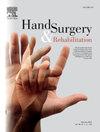沉浸式虚拟现实改编版 6 分钟钉板和套环测试的有效性和可靠性。
IF 1
4区 医学
Q4 ORTHOPEDICS
引用次数: 0
摘要
背景和目的:虚拟现实技术提供了新的临床评估和康复选择,可以补充或在某些情况下替代传统方法。然而,使用虚拟现实工具评估上肢功能能力的适用性尚未得到充分探索。因此,我们开发了一种沉浸式虚拟现实技术,对 6 分钟钉板和套环测试(6PBRT-VR)进行改编。研究的目的是测试 6PBRT-VR 在评估上肢功能能力方面的有效性和可靠性,并评估所提议的工具的性能和可行性:研究对象包括 30 名健康的年轻人。方法:研究对象包括 30 名健康的年轻人,他们首先进行了经典的 6 分钟钉板和套环测试,然后进行了 6PBRT-VR 测试。根据类内相关系数评估 6PBRT-VR 的重测可靠性。并发效度是根据 6PBRT-VR 测试-再测得分(移动环数)与经典的 6 分钟钉板套环测试得分之间的相关性以及 6PBRT-VR 与 6PBRT-VR 之间的相关性进行评估的。根据与手握力和手臂、肩部和手部快速残疾总分的相关性评估了收敛有效性。此外,还测量了心肺反应(基线和每次测试后)。根据改良博格量表对手臂疲劳感进行了评估:结果:6PBRT-VR 的测试-重复测试可靠性极佳,类内相关系数为 0.866(95% 置信区间为 0.737-0.934)。6PBRT-VR 的平均得分与经典的 6 分钟钉板和套环测试的平均得分密切相关(r = 0.817,p 结论:6PBRT-VR 与经典的 6 分钟钉板和套环测试的平均得分密切相关:6PBRT-VR 是一种可靠有效的虚拟工具,可用于评估年轻成年人的上肢功能能力。本文章由计算机程序翻译,如有差异,请以英文原文为准。
Validity and reliability of an immersive virtual reality adaptation of the 6-minute pegboard and ring test
Background and Aim
Virtual reality offers new clinical assessment and rehabilitation options that can complement or, in some cases, replace traditional methods. However, the applicability of using virtual reality tools for assessment of upper limb functional capacity has not been fully explored. We therefore developed an immersive virtual reality adaptation of the 6-Minute Pegboard and Ring Test (6PBRT-VR). The aim of the study was to test the validity and reliability of the 6PBRT-VR for the assessment of upper extremity functional capacity, and to assess the performance and feasibility of the proposed tool.
Methods
Thirty healthy young adults were included in the study. The participants performed the classical 6-Minute Pegboard and Ring Test first and then the 6PBRT-VR. The test-retest reliability of the 6PBRT-VR was assessed on intraclass correlation coefficient. Concurrent validity was assessed on the correlation between the 6PBRT-VR test-retest scores (number of rings moved) and the correlation between the scores from the classical 6-Minute Pegboard and Ring Test and the 6PBRT-VR. Convergent validity was assessed on correlations with handgrip strength and the total Quick Disabilities of the Arm, Shoulder, and Hand score. Cardiorespiratory responses were also measured (at baseline and after each test). Perceived arm fatigue was assessed on the Modified Borg Scale.
Results
The 6PBRT-VR exhibited excellent test-retest reliability, with an intraclass correlation coefficient of 0.866 (95% confidence interval 0.737−0.934). Mean 6PBRT-VR score correlated strongly with the mean score of the classical 6-Minute Pegboard and Ring Test (r = 0.817, p < 0.001). A significant association was found between the 6PBRT-VR and the classical 6-Minute Pegboard and Ring Test in terms of variations in heart rate, systolic blood pressure, and Modified Borg Scale score (p < 0.001). Mean 6PBRT-VR score showed moderate correlations with right (r = 0.571, p = 0.001) and left handgrip strength (r = 0.550, p = 0.002).
Conclusion
The 6PBRT-VR is a reliable and valid virtual tool for assessing upper-extremity functional capacity in young adults.
求助全文
通过发布文献求助,成功后即可免费获取论文全文。
去求助
来源期刊

Hand Surgery & Rehabilitation
Medicine-Surgery
CiteScore
1.70
自引率
27.30%
发文量
0
审稿时长
49 days
期刊介绍:
As the official publication of the French, Belgian and Swiss Societies for Surgery of the Hand, as well as of the French Society of Rehabilitation of the Hand & Upper Limb, ''Hand Surgery and Rehabilitation'' - formerly named "Chirurgie de la Main" - publishes original articles, literature reviews, technical notes, and clinical cases. It is indexed in the main international databases (including Medline). Initially a platform for French-speaking hand surgeons, the journal will now publish its articles in English to disseminate its author''s scientific findings more widely. The journal also includes a biannual supplement in French, the monograph of the French Society for Surgery of the Hand, where comprehensive reviews in the fields of hand, peripheral nerve and upper limb surgery are presented.
Organe officiel de la Société française de chirurgie de la main, de la Société française de Rééducation de la main (SFRM-GEMMSOR), de la Société suisse de chirurgie de la main et du Belgian Hand Group, indexée dans les grandes bases de données internationales (Medline, Embase, Pascal, Scopus), Hand Surgery and Rehabilitation - anciennement titrée Chirurgie de la main - publie des articles originaux, des revues de la littérature, des notes techniques, des cas clinique. Initialement plateforme d''expression francophone de la spécialité, la revue s''oriente désormais vers l''anglais pour devenir une référence scientifique et de formation de la spécialité en France et en Europe. Avec 6 publications en anglais par an, la revue comprend également un supplément biannuel, la monographie du GEM, où sont présentées en français, des mises au point complètes dans les domaines de la chirurgie de la main, des nerfs périphériques et du membre supérieur.
 求助内容:
求助内容: 应助结果提醒方式:
应助结果提醒方式:


